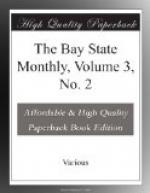A glance over the list of those who have graduated reveals the names of John Hull, Benjamin Franklin and his four fellow-signers of the Declaration of Independence, John Hancock, Sam Adams, Robert Treat Paine, William Hooper; Presidents Leverett, Langdon, Everett and Eliot of Harvard, and Pynchon of Trinity College; Governors James Bowdoin and William Eustis; Lieutenant-Governors Cushing and Winthrop; James Lovell; Adino Paddock, who planted the “Paddock Elms”; Judges Francis Dana, Thomas Dawes, and Charles Jackson; Drs. John C. Warren, James Jackson and Henry I. Bowditch; Professors William D. Peck, Henry W. Torrey, Francis J. Child, Josiah P. Cooke, and William R. Dimmock; Mayors Harrison G. Otis, Samuel A. Eliot and Frederick O. Prince; Honorables Robert C. Winthrop, Charles Francis Adams, George S. Hillard, Charles Sumner, William M. Evarts and Charles Devens; such writers as Ralph Waldo Emerson and John Lothrop Motley, and divines as Right Rev. John B. Fitzpatrick, Roman Catholic bishop of Boston, Right Rev. Theodore Dehon, bishop of South Carolina, and Revs. Cotton Mather, Benjamin Colman, Andrew Eliot, Joseph Tuckerman, William Jenks, Samuel Cooper Thacher, Francis Parkman, N.L. Frothingham, William H. Furness, Alexander Young, Frederick A. Farley, James Freeman Clarke, William Henry Channing, Henry Ward Beecher, John F.W. Ware, Edward E. Hale and Phillips Brooks.
[Footnote 1: Rev. Phillips Brooks.]
* * * * *
THE WHITE AND FRANCONIA MOUNTAINS.
By Fred Myron Colby.
[Illustration: White mountain range from Milan.]
What would the world be without mountains? Geographically, one vast monotony of unchanging surface; geologically, a desert waste. Mountains are the rib-bones of the great skeleton of nature, and they hold together the gorgeous outline of river, valley, lake, and savannah that gives the earth all its varied beauty. Beautiful and grand as they are, they are as useful as ornamental, and serve a momentous necessity in mundane affairs. They are grand landmarks of the Almighty’s power and mercy and goodness, and historically occupy a high position in the lives of nations.
The seers and saints of the old time speak of the strength of the hills as if they were the special gifts of the Creator to his favored people for their defence. The history of later nations has shown us that they have found more in the strength of the hills than defences against the attacks of outside enemies; that they have drawn from them a moral vigor of character, a keenness and activity of intellect, and a love of country, which has produced the most enduring and elevated patriotism. And, indeed, we must bless God for mountains; those who live near them are larger, better, nobler than the denizens of the plains. “Flee to the mountains,” cried the angel to Lot. Ah! there was meaning in the command. Men stagnate upon the plain; they grow indolent, sensual, mediocre there, and are only vivified as they seek the great alphabet of nature, as they pulsate with her in her wondrous heart-beats. It has been the mountain men who have ruled the world.




